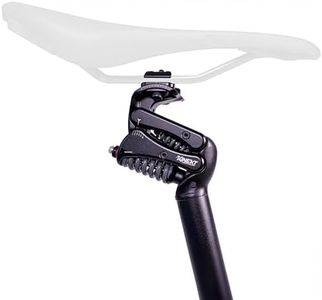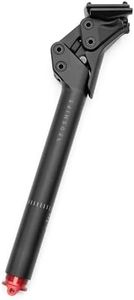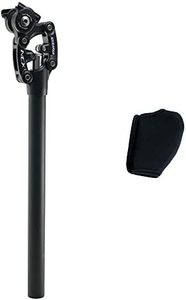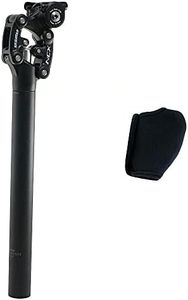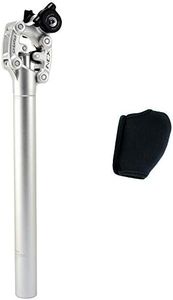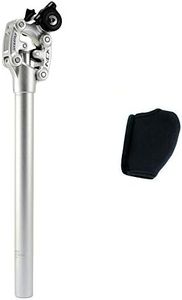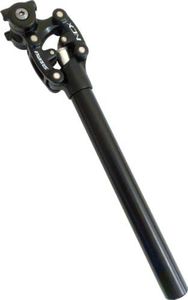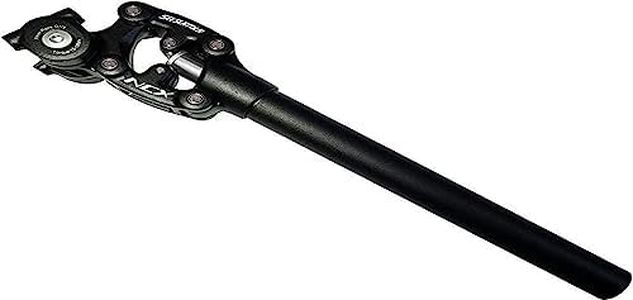We Use CookiesWe use cookies to enhance the security, performance,
functionality and for analytical and promotional activities. By continuing to browse this site you
are agreeing to our privacy policy
10 Best Suspension Seatpost
From leading brands and best sellers available on the web.Buying Guide for the Best Suspension Seatpost
When choosing a suspension seatpost for your bicycle, it's important to consider both your riding style and the types of terrain you expect to encounter. A suspension seatpost can make your ride much more comfortable by absorbing bumps and vibrations, reducing fatigue and allowing you to spend longer periods on the bike without discomfort. Understanding the main specifications will help you select the right model for your needs, ensuring maximum comfort and performance.TravelTravel refers to the distance the seatpost can move up and down to absorb shocks while you ride. More travel means the seatpost can absorb bigger bumps, making for a softer and more cushioned experience. Seatposts with less travel are typically lighter and feel more stable, but they won’t take the edge off large impacts as well. Light riders on smoother roads can get by with travel at the lower end of the range, while heavier riders or those tackling bumpy trails should look for seatposts with greater travel. Your typical route and comfort preferences should guide your choice here.
Suspension MechanismThis is the internal technology that allows the seatpost to compress and absorb shocks. The most common mechanisms are coil springs, elastomers, and air systems. Coil springs offer a traditional, responsive feel and are often more durable, while elastomers provide a smoother, quieter action and are maintenance-free. Air systems are adjustable and lightweight, suitable for fine-tuning comfort. If you want low maintenance and simplicity, elastomers or coil springs make sense; if you want to customize your ride feel, consider an air system.
Diameter and LengthSeatposts come in different diameters and lengths to fit a range of bicycles and rider heights. It’s essential to choose a seatpost with the correct diameter for your bike frame—commonly found printed on the old seatpost or inside the seat tube. The length affects how much you can adjust your seat height. If you’re tall or have a bike with a low seat tube, longer seatposts offer more adjustment. Double-check your bike’s requirements and consider how much adjustment you need before buying.
SetbackSetback refers to how much the seatpost bends backward from the seat tube. A greater setback moves your seat backward, which can affect your riding position and comfort, especially on longer rides. Riders who prefer a more upright position may need little to no setback, while those seeking a more stretched, efficient pedaling posture might go for a larger setback. Your general flexibility, preferred riding style, and bike geometry all play a part in finding the ideal amount.
WeightWeight affects both the overall mass of your bike and how nimble it feels. Lighter seatposts are easier to accelerate and climb with, making them desirable for performance and racing, but may provide slightly less durability or shock absorption. Heavier seatposts might be more robust and absorb more vibrations, which can be good for comfort-oriented or commuting setups. Consider how much you value lightness versus comfort in your riding habits.
Adjustment and MaintenanceSome suspension seatposts offer more adjustment, like tuning the spring rate or preload to match your weight and riding style. Posts with tool-free adjustments are easier to fine-tune, while others might require wrenches. Think about how frequently you want to tweak your suspension and whether you’re comfortable with basic maintenance. Riders who want to 'set and forget' may prefer simpler, low-maintenance options, while tinkerers might enjoy adjustability.


